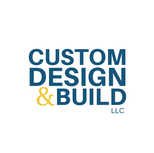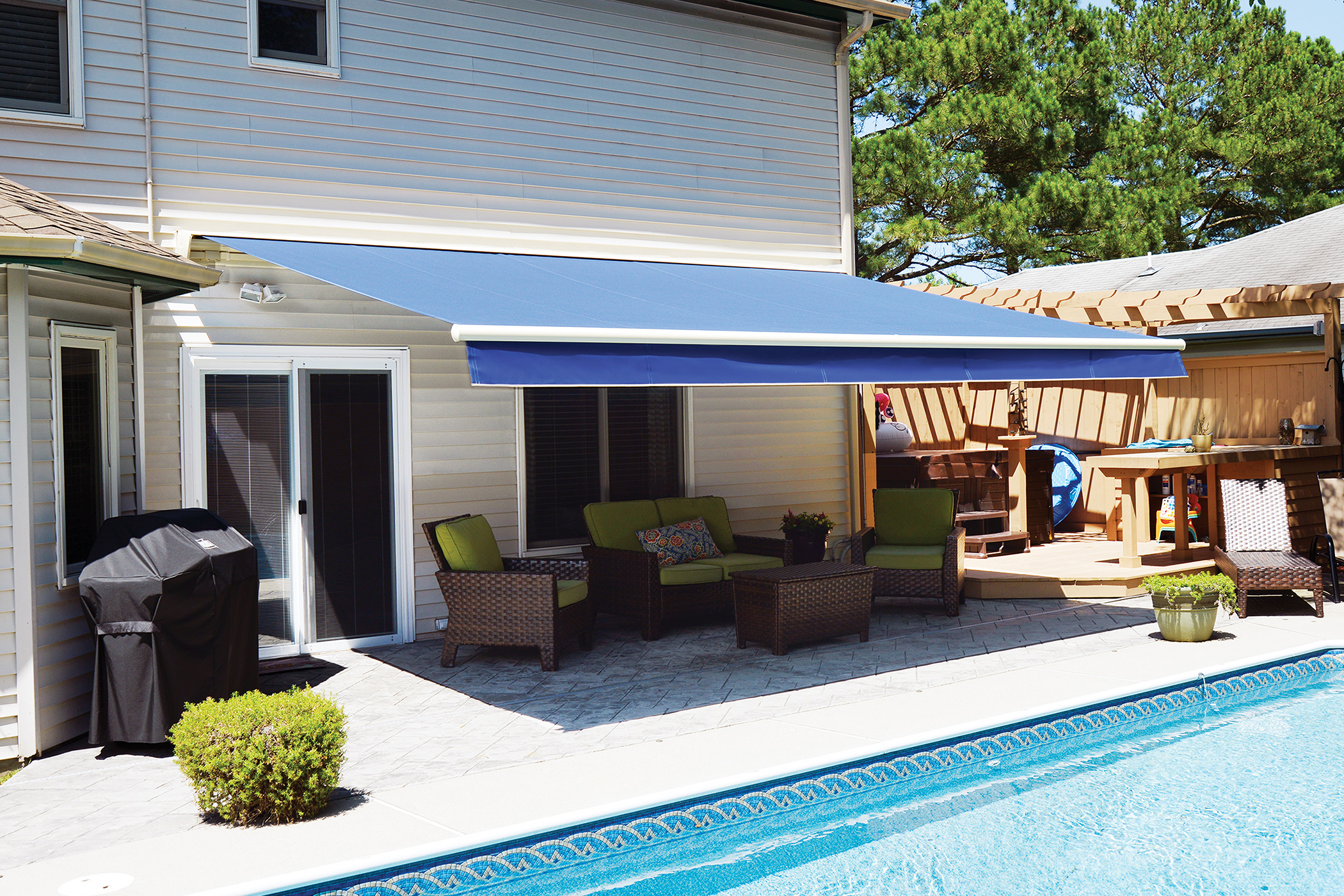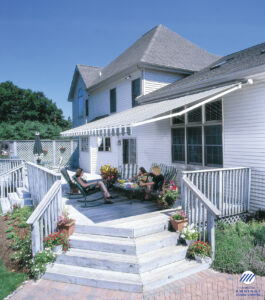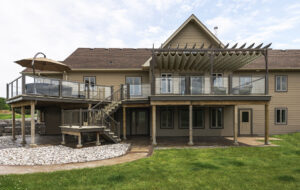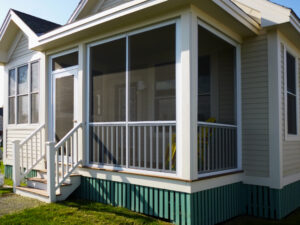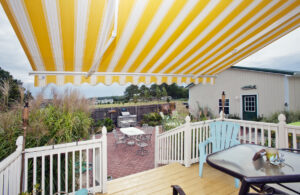Manual vs. Motorized Awnings: Cost & Benefits Comparison Guide
When shopping for a retractable awning for your Maryland home, one of your most important decisions is choosing between manual and motorized operation. While both systems provide the same sun and weather protection, they differ significantly in convenience, cost, and long-term value. This comprehensive guide breaks down everything you need to know about manual versus motorized awnings—from upfront investment and operating costs to daily usability and return on investment—so you can make the best choice for your outdoor living space.
Quick Navigation: Manual Awnings | Motorized Awnings | Cost Comparison | Which Is Right for You?
Understanding Manual and Motorized Awning Systems
Both manual and motorized retractable awnings use the same basic structure: a fabric canopy supported by articulated arms that extend and retract. The difference lies entirely in how you control that extension and retraction. Understanding these operating mechanisms—and their daily practical implications—is essential to choosing the right system for your lifestyle.

Manual Awnings: Traditional, Reliable, Budget-Friendly
How Manual Awnings Work
Manual retractable awnings operate using a hand-crank mechanism, similar to old-fashioned window awnings. A long crank handle—typically removable for safety and aesthetics—attaches to a gear system housed in one end of the awning roller tube. By turning this crank clockwise or counterclockwise, you manually wind or unwind the fabric, causing the arms to extend or retract.
The gear ratio in quality manual systems typically ranges from 4:1 to 6:1, meaning you turn the crank 4-6 times for every full rotation of the roller tube. For a typical 12-foot awning with 10-foot projection, expect to crank for 30-60 seconds to fully extend or retract the canopy. The effort required is minimal—comparable to turning a car steering wheel—but does require you to be physically present and able to perform the motion.
Advantages of Manual Awnings
💰 Significantly Lower Initial Cost
Manual awnings cost $1,500-$2,500 installed for typical residential sizes—roughly 40-50% less than comparable motorized systems. This lower entry price makes manual awnings accessible to more homeowners and allows you to invest saved money in higher-quality fabric, larger coverage area, or complementary outdoor furnishings. For budget-conscious homeowners or those uncertain about long-term awning use, manual systems minimize financial risk.
🔧 Simpler Mechanics, Fewer Failure Points
Without motors, electronics, or sensors, manual awnings have fewer components that can malfunction. The mechanical simplicity means less that can go wrong over time. When issues do arise—typically worn gears after many years of use—repairs are straightforward and inexpensive. This mechanical reliability appeals to homeowners who prefer simpler technology and want to avoid dependence on electrical components that eventually need replacement.
⚡ No Electrical Requirements
Manual awnings install anywhere without needing electrical outlets or wiring. This independence from electricity eliminates installation complications, reduces costs, and ensures your awning works regardless of power outages. For locations where running electrical lines would be expensive or complicated—second-story installations, older homes without convenient outlets, or detached structures—manual operation may be your only practical choice without significant additional electrical work.
🏋️ Minor Physical Activity Benefit
Some homeowners appreciate the small amount of physical engagement manual operation requires. The 30-60 seconds of light cranking provides a moment of intentional interaction with your outdoor space and a tiny bit of arm exercise. This tactile connection creates a ritual some find satisfying—a deliberate transition between indoor and outdoor living rather than pressing a button.
Disadvantages of Manual Awnings
⚠️ Key Limitations to Consider
- Physical presence required: Someone must be home and physically able to crank the awning—problematic for elderly users, those with mobility limitations, or frequent travelers
- Accessibility challenges: Second-story installations can be difficult or impossible to reach with the crank handle
- Weather responsiveness: If you're away when weather suddenly turns severe, your awning remains vulnerable to damage
- Reduced usage frequency: Studies show manual awnings get used 40-50% less often than motorized versions simply because of the minor inconvenience factor
- No automation: Cannot integrate with smart home systems, timers, or sun/wind sensors for automated protection
Motorized Awnings: Modern Convenience & Smart Integration
How Motorized Awnings Work
Motorized awnings use a tubular electric motor housed inside the roller tube. This motor, typically 120V AC powered, receives commands from a control switch, remote control, or smart home system. When activated, the motor rotates the tube, causing the arms to extend or retract smoothly and quietly. Premium systems include adjustable speed settings, soft-start/soft-stop features to prevent jerking, and programmable limit switches that ensure perfect positioning every time.
Modern motorized awnings extend fully in 20-45 seconds depending on size—slightly faster than manual operation but with zero physical effort required. Installation requires a dedicated electrical circuit or outlet within 6-10 feet of the mounting location. Most systems operate on standard household 120V power, though some larger commercial-grade awnings use 240V motors.
Advantages of Motorized Awnings
🎯 Effortless Operation & Maximum Convenience
Press a button and your awning extends or retracts in seconds—no physical effort, no going outside in bad weather to crank, no climbing on ladders for second-story installations. This convenience dramatically increases awning usage. Homeowners with motorized systems report using their awnings 2-3 times more frequently than those with manual systems simply because it's so effortless. More usage means better return on your investment through increased outdoor living time and energy savings.
🏠 Smart Home Integration & Automation
Modern motorized awnings integrate seamlessly with smart home systems like Amazon Alexa, Google Home, Apple HomeKit, and home automation platforms. Voice commands like "Alexa, extend the awning" provide ultimate convenience. Set timers to automatically extend your awning at 2 PM daily during summer to prevent afternoon heat, then retract at sunset. This automation ensures your awning provides maximum benefit even when you're not actively thinking about it—optimizing energy savings and furniture protection without requiring daily attention.
🌪️ Wind & Sun Sensors for Automatic Protection
Premium motorized systems accommodate wind and sun sensors that provide automatic protection for your investment. Wind sensors detect when gusts exceed safe thresholds (typically 20-25 mph) and automatically retract your awning to prevent damage—critical protection when you're away from home. Sun sensors can automatically extend your awning when sunlight reaches certain intensity levels, maximizing energy savings and furniture protection without requiring you to monitor weather conditions constantly. These sensors effectively turn your awning into a set-it-and-forget-it system that manages itself intelligently.
♿ Accessibility for All Users
Motorized operation makes awnings accessible to elderly homeowners, those with limited mobility or strength, and anyone who finds manual cranking difficult. Remote controls mean you never need to go outside in rain to extend coverage or climb to reach second-story installations. For aging-in-place considerations, motorized awnings ensure you can continue enjoying your outdoor space regardless of physical limitations that develop over time.
📱 Remote Operation from Anywhere
WiFi-enabled motorized awnings allow smartphone control from anywhere in the world. Unexpected thunderstorm while you're at work? Retract your awning from your office. Want to extend coverage before arriving home? Do it from your car. This remote capability provides peace of mind and protects your investment even when you're not home—something completely impossible with manual systems.
Disadvantages of Motorized Awnings
⚠️ Considerations & Tradeoffs
- Higher upfront cost: $2,500-$6,500 installed—approximately double the price of manual systems
- Electrical requirements: Needs dedicated outlet or circuit, adding installation complexity and cost if electrical work is needed
- Motor replacement eventually needed: Motors typically last 10-15 years but will eventually need replacement ($400-$800 for motor plus labor)
- Potential for electronic failures: More components mean more things that can malfunction—remotes, sensors, control boards
- Power dependency: Won't operate during power outages (though some systems offer battery backup or manual override options)
Detailed Cost Comparison: Manual vs. Motorized
Initial Purchase & Installation Costs
| Cost Category | Manual Awning | Motorized Awning | Difference |
|---|---|---|---|
| Basic Awning Unit (12x10 ft) | $1,200-$1,800 | $2,200-$4,000 | +$1,000-$2,200 |
| Professional Installation | $300-$500 | $400-$800 | +$100-$300 |
| Electrical Work (if needed) | $0 | $0-$500 | +$0-$500 |
| Wind/Sun Sensors (optional) | Not available | $150-$400 | +$150-$400 |
| TOTAL INITIAL INVESTMENT | $1,500-$2,300 | $2,750-$5,700 | +$1,250-$3,400 |
Long-Term Operating & Maintenance Costs (15-Year Projection)
| Cost Factor | Manual Awning | Motorized Awning |
|---|---|---|
| Annual Electricity Costs | $0 | $3-$8/year |
| Motor Replacement (Year 10-12) | $0 | $400-$800 |
| Gear Mechanism Service | $100-$200 (if needed) | $0 |
| Remote Control Replacement | N/A | $50-$150 (if lost/broken) |
| Fabric Replacement (Year 10) | $400-$700 | $400-$700 |
| 15-YEAR TOTAL COST | $2,000-$3,200 | $3,250-$6,600 |
💡 Value Perspective: Cost Per Year of Use
Over 15 years, manual awnings cost approximately $135-$215 per year, while motorized systems cost $200-$440 per year. The difference—$65-$225 annually—amounts to roughly $5-$19 per month for the convenience, automation, and increased usage that motorized systems provide. When you consider that homeowners use motorized awnings 2-3x more frequently, the cost-per-use actually makes motorized systems comparable or even better value than manual options.
Which Awning Type Is Right for You?
Choose Manual Awnings If...
- Budget is your primary constraint and you need to minimize upfront investment
- You're at home frequently during the day and don't mind the minimal physical effort of cranking
- You prefer simplicity and want to avoid dependence on motors and electronics
- Your installation location lacks convenient electrical access and running power would be expensive
- You're uncertain about long-term awning use and want to minimize financial risk
- You value mechanical reliability over modern convenience features
- You don't need smart home integration or automated operation
Choose Motorized Awnings If...
- Convenience is a priority and you want effortless operation
- You're frequently away from home and want remote control or automation
- You have mobility limitations or physical conditions that make cranking difficult
- You want smart home integration and automated scheduling
- Your awning will be on second story or hard-to-reach location
- You value wind/sun sensor protection for your investment
- You're planning long-term and want features that support aging in place
- Budget allows for higher initial investment in exchange for long-term convenience
- You want maximum usage to optimize ROI through energy savings and outdoor living time
Hybrid Solution: Motor Retrofits
Can't decide? Consider starting with a manual awning and upgrading later. Many manual awnings can be retrofitted with motors for $800-$1,500, allowing you to test awning ownership at lower cost before committing to motorization. This approach works well if you're uncertain about usage patterns or if budget constraints are temporary. However, not all manual awnings support motorization retrofits, so discuss this option with your installer if you're considering the upgrade path.
Real-World Scenarios: Which Homeowners Choose What
Scenario 1: Young Family, Single Income, First Awning
Recommendation: Manual
Budget constraints make the $1,000+ savings significant. With young children, parents are usually home during prime awning hours. The physical effort is negligible for active adults. As financial situation improves in 5-10 years, they can upgrade to motorized or replace with a larger motorized system.
Scenario 2: Dual-Income Professionals, No Kids, Tech-Savvy
Recommendation: Motorized with Smart Features
Away from home 9-6 daily. Value convenience highly and budget isn't the primary constraint. Smart home integration matches lifestyle. Want awning protection even when traveling. Remote control from work allows extending coverage before arriving home for evening entertaining.
Scenario 3: Retirees, Fixed Income, Home Most Days
Recommendation: Motorized (Despite Budget Consciousness)
While budget-conscious, motorized operation accommodates current or future mobility limitations. The investment supports aging in place, allowing continued outdoor enjoyment regardless of physical changes. Automation compensates for memory or routine lapses. The additional cost is justified by accessibility and long-term usability.
Scenario 4: Vacation Home, Used Seasonally
Recommendation: Motorized with Wind Sensor
Property is unoccupied much of the year. Wind sensor provides automatic protection during storms when no one is present. Remote operation allows extending awning before arrival or retracting before leaving. The additional investment protects a valuable awning from damage that manual operation couldn't prevent when the property is vacant.
Ready to Choose Your Perfect Awning System?
Custom Design & Build LLC helps Maryland homeowners select and install the ideal awning system for their needs and budget. Whether you choose manual or motorized, we ensure professional installation and provide expert guidance throughout your decision process. Let us help you transform your outdoor living space with the right awning solution.
📞 Call us today at (443) 981-1835 to discuss your awning options
Frequently Asked Questions
Can I upgrade my manual awning to motorized later?
Many manual awnings can be retrofitted with motors, but not all models support this upgrade. The retrofit typically costs $800-$1,500 including motor, installation, and necessary electrical work. If you're considering this path, discuss motorization compatibility with your installer before purchasing your initial manual awning. Some manufacturers design their manual systems with motorization in mind, making future upgrades seamless. Others require complete mechanism replacement, which can be cost-prohibitive.
How long do motorized awning motors typically last?
Quality motors from reputable manufacturers typically last 10-15 years with normal use. Factors affecting longevity include usage frequency, environmental conditions, and proper maintenance. Most motors are rated for 5,000-10,000 cycles (extend/retract operations). For typical residential use (extending once daily during warm months), this translates to many years of reliable operation. When motors do eventually fail, replacement is straightforward and costs $400-$800 installed.
What happens to motorized awnings during power outages?
Standard motorized awnings won't operate during power outages. However, several solutions exist: Some premium systems offer battery backup that provides 10-20 cycles during outages. Others include manual override cranks that allow operation without power. Solar-powered systems operate independently of home electrical supply. If power outage operation is important to you, discuss these options with your installer. For most homeowners, power outages are infrequent enough that this limitation isn't a significant concern.
Are wind and sun sensors worth the extra cost?
For most homeowners, yes—especially if you're frequently away from home. Wind sensors ($150-$250) provide automatic protection that can prevent thousands in damage from unexpected storms. Sun sensors ($100-$200) maximize energy savings by automatically managing your awning based on sunlight intensity. Together, these sensors effectively turn your awning into a set-it-and-forget-it system that manages itself. The $250-$450 investment often pays for itself through prevented damage and optimized energy savings within 2-3 years.
Is the additional cost of motorized awnings worth it?
For most homeowners, yes—but it depends on your priorities. The $1,000-$3,000 premium buys effortless convenience, increased usage (homeowners use motorized awnings 2-3x more frequently), smart home integration, automated protection, and accessibility for all ages and abilities. Over 15 years, the difference amounts to $5-$19 per month. If you value convenience, are frequently away from home, want smart features, or have any mobility concerns, motorized awnings deliver excellent return on the additional investment. However, if budget is extremely tight and you're home during prime awning hours, manual systems provide the same sun and weather protection at lower cost.
How difficult is it to operate a manual awning?
Operating a manual awning requires minimal effort—comparable to turning a car steering wheel. For a typical 12-foot awning, you'll crank for 30-60 seconds to fully extend or retract. The motion is smooth and requires no significant strength. Most adults, including seniors without mobility issues, handle manual operation easily. However, those with arthritis, limited arm strength, or restricted mobility may find even this minimal effort challenging. If you're uncertain about your ability to operate a manual crank long-term, consider motorized for peace of mind and future-proofing.
Expert Awning Installation Throughout Maryland
Custom Design & Build LLC proudly serves Aberdeen, Bel Air, Fallston, Forest Hill, Joppatowne, White Marsh, and all of Harford County, Baltimore County, and Cecil County with professional awning sales and installation.
Contact us today: (443) 981-1835 | [email protected]
